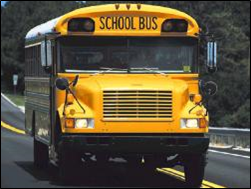Seat belts on School buses
January 16, 2020
School buses are the safest means of transportation even without seatbelts according to the National Highway Traffic Safety Administration (NHTSA), but the debate on whether school buses should have seat belts still carries on.
Having seatbelts on the bus could offer an increase in rider behavior issues because they must remain seated and at the same time reduce driver distraction. On the other hand, this could also cause some students to become violent and use the seatbelt as a weapon to injure themselves or other riders. It is difficult to de-pict if this would help or hurt student safety.
Senior Harlie Gibson com-ments, “I think school buses should have seat belts for kinder-garteners, but in some cases, seat belts could be used unsafely be-tween the different age groups and could harm surrounding stu-dents, because many kids encoun-ter bullies on the bus.”
Due to their size and weight, buses can sustain crashes easier. The Federal Motor Vehicle Safety standards set the rule that smaller school buses weighing 10,000 pounds or less must have lap-shoulder (three-point) belts. These buses are often used to transport younger kids, special needs students or smaller groups.
Tyler Jones, a senior who has ridden the bus for the majority of his schooling career answers the question whether or not school buses should have seatbelts by saying, “Yes, because if kids feel unsafe they should at least have the option to wear one.”
School bus seatbelt laws are required in six states in the U.S.: California, Florida, New Jersey, New York, Louisiana, and Texas. California and Texas are the only states that necessitate the three-point seatbelts. On the authority of the National Conference of State Legislatures (NCSL), since 2007 at least 32 states and Puerto Rico have considered putting leg-islation into the school bus seat-belt argument, but it’s not as easy as it seems.
When asked if school buses should have seatbelts, Milford High School police Liaison of-ficer Eric DeLanoy comments, “I think they should; the problem is that it would be very difficult for one bus driver to make sure all kids wore their seat belts, and I know there would be a lot of kids who wouldn’t put their seatbelts on.”
While many states have de-bated whether or not students should be wearing seat belts on buses, the issue raises other con-cerns as well.
The question isn’t only “should school buses have seat-belts?” but how would this affect response time in an emergency situation?
NHTSA data shows that most of the 301 children killed from 2006-2015 in bus-related crashes were pedestrians or in another vehicle with only 54 of the kids being passengers of the bus. More than 35,000 people died in 2015 alone in the United States in automobile accidents, according to The National High-way and Traffic Safety Admin-istration, so the amount of chil-dren killed in bus accidents is relatively low.
Adding seat belts into new buses would cost an estimated $7000 to $10,000 per bus on top of the bus’s original cost of about $80,000 to $120,000, according to PBS.org.
Rich Casey, a transportation director in Nebraska, says, “There is no scientific or empirical data that shows they [seat belts] would offer more protection than the current system,” according to the NSCL.
Though seatbelts have per-formed well in high-speed crashes and could prevent possible inju-ries in roll-over or side-impact crashes; the NHTSA is one of the most well-known entities arguing against school bus seat belts. The reasoning behind this is a design used in buses called “compartmentalization.” This concept makes the interior of a bus safe for students without the need for a seatbelt by, “strong, closely-spaced seats that have energy-absorbing seat backs.”
Some parents may think isn’t enough protection, but the NHTSA is confident that buses are the safest vehicle on the road and their guidelines prove to be working.

